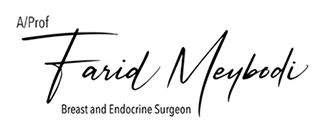Thyroglossal duct cysts
What are Thyroglossal Duct Cysts?
Thyroglossal duct cysts are fluid-filled lumps or masses located just above the larynx (voice box) in front of the neck. They are formed from the leftover cells and tissues during formation of the thyroid gland at the time of embryonic development. It is a congenital anomaly that usually occurs in children, but may also occur at any age from infancy through adolescence. Thyroglossal duct cysts are the second most common benign neck masses that account for 70 per cent of all congenital neck deformities.
What Causes Thyroglossal Duct Cysts?
When the thyroid gland develops during formation of the embryo, it begins at the foundation of the tongue and travels down the neck via a canal called the thyroglossal duct. This duct usually ceases to exist once the thyroid reaches its ultimate place in the neck. Sometimes, sections of the duct remain to form pockets or cavities called cysts. These cysts can become infected and fill with mucus or fluid, enlarging in size causing difficulty in swallowing or obstruction of breathing airways.
Characteristics of Thyroglossal Duct Cysts
Some of the salient features of thyroglossal duct cysts include:
- Round, mushy, painless lump that is notable in the front of the neck
- Lump usually moves when a person swallows or sticks his tongue out
- Even though the cyst is present at birth, it is normally not discovered until age 2
- Mostly diagnosed during preschool or in mid-adolescence
Symptoms of Thyroglossal Duct Cysts
Some of the common signs and symptoms of thyroglossal duct cysts include:
- A small, soft, round, painless lump in the anterior part of the neck
- Difficulty breathing or swallowing
- Redness, swelling, and tenderness of the lump, if infected
- Drainage of fluid or mucus through a small opening in the skin near the lump
Diagnosis of Thyroglossal Duct Cysts
In order to diagnose thyroglossal duct cysts, your physician will perform a thorough review of an individual’s medical history and physical examination. To obtain additional information and confirm the diagnosis, your physician may order certain diagnostic procedures such as:
- Blood tests
- Thyroid scans
- Ultrasound examination
- Fine needle aspiration
Treatment for Thyroglossal Duct Cysts
The nature of the treatment will depend on the person’s age, symptoms, general health, and severity of the condition.
Antibiotics are normally given to help treat bacterial infections of the cysts. However, if the cysts have been infected and are causing trouble swallowing or breathing, then a surgery called Sistrunk procedure is recommended.
The Sistrunk procedure involves the following steps:
- General anaesthesia is administered to keep you asleep throughout the procedure.
- A small incision is made over the front section of the neck to access the tissue and muscles over the cyst.
- The cyst tissue is separated from the surrounding tissues.
- A small section from the inside of the hyoid bone (a bone above your laryngeal prominence or Adam’s apple that appears like a horseshoe), along with any leftover tissue of the thyroglossal duct is also removed.
- Muscles and tissues around the hyoid bone are closed in layers and dressings applied.
Postoperative Recovery
The surgery usually takes a couple of hours and an overnight hospital stay may be required. Taking a week off from work or school is advised to ensure adequate rest from surgery. Refrain from driving for a couple of weeks and avoid long-haul flights for 2 months. Ensure to follow all the instructions provided by your doctor on wound care management, bathing, diet, driving, exercises, and other recommendations. You will be able to return to your normal activities in a week or two. A follow-up appointment will be scheduled to monitor your overall progress.
Risks and Complications
Sistrunk procedure for thyroglossal duct cysts is a relatively safe procedure; however, as with any surgery, there are risks and complications that could occur such as:
- Bleeding
- Infection
- Scarring







